- ON THE DECADE
- THE DECADE'S CAMPAIGN
- REPORTING ON PROGRESS
- THE DECADE'S PROGRAMMES
- FOCUS AREAS
-
- Access to sanitation
- Financing water
- Gender and water
- Human right to water
- Integrated Water Resources Management
- Transboundary waters
- Water and cities
- Water and energy
- Water and food security
- Water and sustainable development
- Water and the green economy
- Water cooperation
- Water quality
- Water scarcity
- FOCUS REGIONS
- RESOURCES FOR
- UN e-RESOURCES
Water and Energy

Energy and water are intricately connected. All sources of energy (including electricity) require water in their production processes: the extraction of raw materials, cooling in thermal processes, in cleaning processes, cultivation of crops for biofuels, and powering turbines. Energy is itself required to make water resources available for human use and consumption (including irrigation) through pumping, transportation, treatment, and desalination.
Society’s acumen on the conjoined management of water and energy resources has developed over time. The relationship, as defined today, stands as simple as the energy intensity in the water sector to water intensity in the energy sector. It is the amount of water needed directly or indirectly for exploration, extraction, generation and transmission of energy, and the amount of energy needed for extraction, transportation, distribution, collection, treatment and end use of water. The energy and water nexus was coined as a focused area of study under the entire nexus to develop an understanding of the interdependencies and complications of water and energy alone. The water for energy and energy for water dependencies revolve around many elemental issues ranging from water management systems and water infrastructure to sustainable energy and efficient systems.
An integrated development of the energy and water policies is of paramount importance and not in isolation from each other. With high risks that the energy sector is now exposed to, the importance of including water in its strategic plan is more essential than ever before.
Water for Energy
Energy availability is the pillar for social and economic progress in a society. Water holds the key to development of energy infrastructures and remains fundamental throughout the lifecycle of energy infrastructure and resource development, from extraction of raw materials, purification, washing and treatment of raw materials to coolants in nuclear or thermal power plants to being a fuel for hydropower plants.
Global Forum on Environment: New Perspectives on the Water-Energy-Food-Nexus. OECD. Paris, France (November, 27-28)
International Conference on Water, Energy, and Food Nexus for Sustainable Development. Conference organized by SEA-EU-NET Partners in Science. Pattaya City, Thailand (November 19-21, 2014)
What works at the nexus? Conference organized by The Nexus Network. London (November 27, 2014)
IWA World Water Congress & Exhibition, Lisbon/Portugal (September, 21-26, 2014)
Stockholm World Water Week 2014. Organized by SIWI. Stockholm, Sweden (August 31- September 5, 2014)
International Conference on Water-Food-Energy Nexus in Drylands: Bridging Science and Policy. Organized by the OCP Policy Center in partnership with the Barcelona Centre for International Affairs (CIDOB), King’s College London and Texas A&M University. Rabat, Morocco (June 11-13, 2014)
International Conference Sustainability in the Water-Energy-Food Nexus. Organized by GWSP. Bonn, Germany (May 19-20, 2014)
African Utility Week, Panel: Water-Energy-Food nexus. Cape Town, South Africa (May 13-14, 2014)
The Global Water Investment Summit. Water Innovation Panel Session - Water Energy Food Nexus (May 7-8, 2014)
Connecting the dots 2014: The Climate, Energy, Food, and Water Nexus. Stanford University. California, US (April 18, 2014)
The Water-Energy Nexus: Sustainability and Global Challenges. A US-China EcoPartnerships conference organized by New York Institute of Technology and Peking University. Beijing, China (April 17, 2014)
Nexus 2014: Water, Food, Climate and Energy Conference. Chapel Hill, USA. (March 3-7, 2014)
World Future Energy Summit, Abu Dhabi, UAE (January 21, 2014)
Energy for Water
Energy is of primary importance for water management and developments. The water infrastructures solely rely on energy throughout its value chain, groundwater extraction, transportation, purification, distillation, distribution, collection and wastewater management and treatment. Energy does not only play an important role in the functioning of water infrastructures, but also in the operational costs.
Did you know?
- 2.5 billion people have unreliable or no access to electricity
- As a general trend, energy and electricity consumption are likely to increase over the next 25 years in all world regions, with the majority of this increase occurring in non-OECD countries.
- By 2035, energy consumption will increase by 50% which will increase the energy sector's water consumption by 85%
- Today 15% of global water withdrawals are for energy production
- Hydropower supplies about 20% of the world’s electricity, a share that has remained stable since the 1990s.
- Energy requirements for surface water pumping are generally 30% lower than for groundwater pumping. It can be expected that groundwater will become increasingly energy intensive as water tables fall in several regions.
- Globally, irrigation water allocated to biofuel production is estimated at 44 km3, or 2% of all irrigation water. Under current production conditions it takes an average of roughly 2,500 litres of water (about 820 litres of it irrigation water) to produce 1 litre of liquid biofuel (the same amount needed on average to produce food for one person for one day).
Sources: United Nations World Water Development Report 4. Volume 1: Managing Water under Uncertainty and Risk. WWAP, 2012
United Nations World Water Development Report 3. Water in a Changing World. WWAP, 2009.
World Bank’s Thirsty Energy initiative, 2014
Water, Energy and the MDGs
Improved energy and water services are a necessary input for achieving most MDGs. These are some examples:
- Improved water and energy services reduce the burden on women and young girls who often spend several hours each day collecting water and gathering biomass for cooking thus free up time for their participation in education and income generation activities. The provision of cleaner water and energy services is also linked to improvements in the health, micro-enterprise activity, and agricultural productivity of women.
- The lack of availability and access to basic water and energy services impedes individuals and communities from achieving greater levels of well-being and benefitting from opportunities for social and economic development. This is particularly true for the most poor and vulnerable segments of the population, such as women and children. Investing in water and energy services will lead to increased levels of human health, reduced levels of poverty and indigence, and increased opportunities for education and employment, resulting in overall national economic development.
- In many poor countries, biomass accounts for 90% of household energy consumption. Hence, ecosystem services not only sustain energy supply in low-income countries, but they are also critically affected by the predominant choice of energy carrier and aggregate consumption levels. Water security and ecosystems have a reciprocal relationship necessary for the enhancement of both and thereby conserving energy.
UN initiatives which are helping to raise the issue...
• Decade of Sustainable Energy for All (2014-2024)
Through Resolution 67/215, the United Nations General Assembly declared the decade 2014-2024 as the Decade of Sustainable Energy for All. The Decade underscores the importance of energy issues for sustainable development and for the elaboration of the post-2015 development agenda. It highlights the importance of improving energy efficiency, increasing the share of renewable energy and cleaner and energy-efficient technologies. Enhancing the efficiency of the energy models would reduce the stress on water.
• Sustainable Energy for All initiative
The Sustainable Energy for All initiative is a multi-stakeholder partnership between governments, the private sector, and civil society. Launched by the UN Secretary-General in 2011, it has three interlinked objectives to be achieved by 2030: (1) Ensure universal access to modern energy services; (2) Double the global rate of improvement in energy efficiency; (3) Double the share of renewable energy in the global energy mix.
• 2014 UN-Water Annual International Zaragoza Conference. Preparing for World Water Day 2014: Partnerships for improving water and energy access, efficiency and sustainability. 13-16 January 2014
The UN-Water Annual Zaragoza Conferences serve UN-Water to prepare for World Water Day. The Zaragoza Conference reached beyond the "water for energy" and/or "energy for water" concept focusing on a more practical examination of how tools and partnerships help developing appropriate joint responses and what are the measures for managing trade-offs, identifying synergies, and maximizing co-benefits. Discussions centered on how partnerships can help implement responses to achieve water and energy efficiency, secured access and sustainability.
• UN-Energy
Established in 2004, UN-Energy was initiated as a mechanism to promote coherence and inter-agency collaboration in the field of energy and to develop increased collective engagement between the United Nations and other key external stakeholders. UN-Energy's work is organized around three thematic clusters: (1) Energy access; (2) Renewable energy; and (3) Energy efficiency.
• United Nations Industrial Development Organization (UNIDO)
UNIDO's primary objective is the promotion and acceleration of industrial development in developing countries and countries with economies in transition using sustainable practices primarily focused on water and energy security, and the promotion of international industrial cooperation towards sustainable development.
• United Nations Environment Programme (UNEP)
UNEP coordinates United Nations environmental activities, assisting developing countries in implementing environmentally sound policies and practices. The Water-Energy Nexus, its interdependencies and best practices related to energy and water security have been highlighted in its wide range of publications. UNEP has played a significant role in developing international water, energy and other international conventions, promoting environmental science and information and illustrating the way those can be implemented in conjunction with policy, working on the development and implementation of policy with national governments, regional institutions in conjunction with Non-Governmental Organizations (NGOs).
• World Bank’s Thirsty Energy Initiative
This initiative aims to support proactively countries’ efforts to address challenges in energy and water management. With the energy sector as an entry point, Thirsty Energy quantifies trade-offs and identifies synergies between water and energy resource management. The initiative demonstrates the importance of combined energy and water management approaches through demand-based work in several countries, thus providing examples of how evidence-based operational tools in resource management can enhance sustainable development.
• World Water Day 2014: Water and Energy
World Water Day (WWD) is held annually on 22 March as a means of focusing attention on the importance of freshwater and advocating for the sustainable management of freshwater resources. Each year, World Water Day highlights a specific aspect of freshwater. In 2014 the focus was on water and energy issues. The United Nations University (UNU) and the United Nations Industrial Development Organization (UNIDO) led official celebrations on behalf of UN-Water.
To know more…
 Other recent conference and international events
Other recent conference and international events
Water Monographies II: Water & Energy World Council of Civil Engineers (WCCE), UN-Water Decade Programme on Advocacy and Communication (UNW-DPAC), AQUAE Foundation, 2014
This report introduces the new WCCE initiative, Water & Energy presented on the occasion of our 9th General Assembly which took place in Lisbon on November the 25th. This initiative is published in collaboration with UN-Water and AQUAE Foundation and is published in English and Spanish.
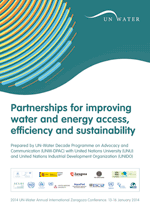 Partnerships for improving water and energy access, efficiency and sustainability
Partnerships for improving water and energy access, efficiency and sustainability
UN-Water Decade Programme on Advocacy and Communication (UNW-DPAC), United Nations University (UNU), United Nations Industrial Development Organization (UNIDO). August 2014
This report brings together outputs from the UN-Water Zaragoza Conference 2014, summarising contributions from different UN agencies and programmes, more than 120 experts, representatives of international companies in the water and energy sector, governmental and non-governmental organisations. An introduction provides insight into the interlinkages between water and energy and the prospects for a sustainable future. The report then examines the future of the water-energy nexus and partnership under 6 key headings: The UN and the Water-Energy Nexus; Water and Energy Scenarios and Challenges; The Water and Energy Nexus: Opportunities and Choices; Making the Case for Partnerships; Building Partnerships–partnerships in practice; and Key Lessons on Partnerships.
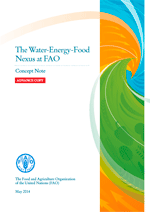 The Water-Food-Energy Nexus at FAO
The Water-Food-Energy Nexus at FAO
Food and Agricultural Organization of the United Nations (FAO). May 2014
This concept note is an analysis of the water-food-energy nexus starting with an explanation of what each focus area represents and how the complex interactions between all three can be managed. It asks 'What is the added value of a nexus approach?' Followed by an exploration of the sustainability debate and the working areas of the water-food-energy nexus, through the following sub headings: A cross-sectoral and dynamic perspective; Is the concept of the Water-Food-Energy nexus just “some old wine in new bottles” or does it bring something new to the table? Framing the Water-Food-Energy nexus within the broader sustainability debate; a nexus approach for whom? The concept note concludes with a chapter on the 'Working areas of the Water-Food-Energy nexus.'
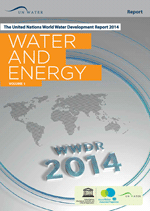 United Nations World Water Development Report 2014. Water and Energy. Volumes 1 and 2
United Nations World Water Development Report 2014. Water and Energy. Volumes 1 and 2
United Nations World Water Assessment Programme (WWAP), UN-Water. March 2014
The 5th edition of the United Nations World Water Development Report (WWDR 2014) examines the close interdependency between water and energy. The report demonstrates how water and energy are closely interconnected, the choices and actions made in one domain greatly affecting the other; it addresses a wide range of key issues, including agriculture, cities, industry, infrastructure and the environment. Volume 1 provides a comprehensive overview of major and emerging trends from around the world, with examples of how some of the trend-related challenges have been addressed, their implications for policy-makers and further actions that can be taken by stakeholders and the international community. Volume 2 ‘Facing the challenges’ summarises the issues highlighted in volume 1, with the support of 13 case studies from around the world. The case studies featured bolster the critical findings of the report by illustrating that an array of opportunities exist to exploit the benefits of synergies, such as energy recovery from sewage water, the use of solar energy for wastewater treatment and electricity production at drinking water power plants. It also contains an annex on data and indicators.
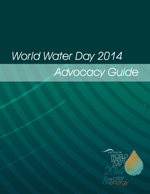 World Water Day 2014: Advocacy Guide
World Water Day 2014: Advocacy Guide
UN-Water. January 2014
This guide is designed to give detailed advocacy advice through three main areas: learning, action and sharing. Although the information relates specifically to the World Water Day 2014 event, the guidance itself can be applied to any water and energy campaign as it contains a rich resource of facts and figures, specific messages and campaign materials relating to water and energy.
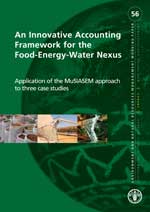 An Innovative Accounting Framework for the Food-Energy-Water Nexus. Application of the MuSIASEM approach to three case studies
An Innovative Accounting Framework for the Food-Energy-Water Nexus. Application of the MuSIASEM approach to three case studies
Food and Agriculture Organization of the United Nations (FAO). October 2013
This report presents the results of the application of an integrated analysis approach, the Multi-Scale Integrated Assessment of Society and Ecosystem Metabolism (MuSIASEM), to three case studies: (i) An analysis of the option to produce biofuel from sugarcane in the Republic of Mauritius; (ii) An exploration of the future of grain production in the Indian state of Punjab; (iii) An assessment of two alternative energy sources to produce electricity in the Republic of South Africa. The report provides a summary of the final results and is organized in three sections: chapter 1 provides a general description of the multi-scale integrated assessment of society and ecosystem metabolism applied to the food-energy-water nexus-assessment; chapter 2 illustrates the application of the developed approach to the three case studies; and chapter 3 summarizes lessons learned in terms of strength and weakness of the proposed tool.
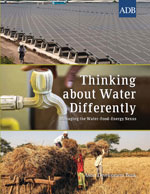 Thinking about Water Differently: Managing the Water–Food–Energy Nexus
Thinking about Water Differently: Managing the Water–Food–Energy Nexus
Asian Development Bank. September 2013
This publication is the result of a scoping study initiated by the Asian Development Bank to better understand the issues associated with the water-food-energy nexus in Asia and the Pacific. While the report talks about water for energy (in page 12), where it focuses on expanding energy production capacity (keeping low carbon growth in perspective) thereby requiring greater access to freshwater, it also focuses on energy for water and wastewater treatment (page 15).
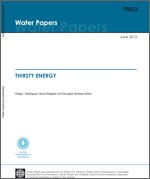 Thirsty Energy
Thirsty Energy
World Bank Water and Sanitation Program (WSP). June 2013
This report stresses on the importance of optimizing the use of water and energy. It highlights high risks of the energy sector, the importance of including water in its strategic plan and the development of energy and water relationships. Section one examines the existing models, literature, and management frameworks on the water-energy nexus, as it seeks to determine what gaps exist. Section two describes the water demands of power generation in order to identify potential areas of future uncertainty and delineate areas where integrated energy-water management may improve the reliability of operating power plants and the viability of schemes. Finally, section three describes possible solutions that may alleviate challenges resulting from the link between energy and water by improving energy efficiency and integrating water resources management into energy planning.
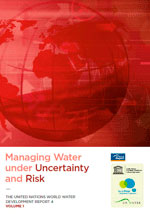 United Nations World Water Development Report 4. Volume 1: Managing Water under Uncertainty and Risk
United Nations World Water Development Report 4. Volume 1: Managing Water under Uncertainty and Risk
United Nations Educational, Scientific and Cultural Organization (UNESCO), United Nations World Water Assessment Programme (WWAP), UN-Water. March 2012
The World Water Development Report gives an overall picture of the state of the world's freshwater resources and analyses pressures from decisions that drive demand for water and affect its availability. Volume 1 focuses on status, trends, challenges and the issue of managing water under uncertainty and risk. This volume presents an overview of the Water-Energy Nexus with Chapter 1 and Chapter 2 stressing on the importance of energy and water and their interdependence. A detailed analysis of water for energy and energy for water can be seen in Page 52 and 57 respectively.
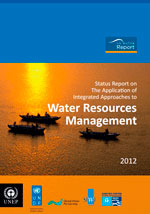 Status Report on the application of integrated approaches to water resources management 2012
Status Report on the application of integrated approaches to water resources management 2012
United Nations Environment Programme (UNEP), UN-Water. 2012
Based on a global survey assessing the progress and outcomes of the application of integrated approaches to the development, management and use of water resources, this UN-Water report includes lessons learned and recommendations, as well as focus areas for action. The report attempts to outline the issues that need to be addressed with key focus areas for action like ‘Investment Plans and Programs’ and ‘Issues for water development and use’ in Page 40 and Page 52 respectively. The interdependence of water and energy is explained in page 65 along with some useful graphs.
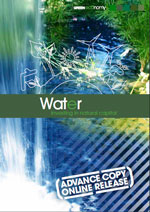 Towards a Green Economy: Pathways to Sustainable Development and Poverty Eradication. Chapter 3 on 'Water. Investing in natural capital'
Towards a Green Economy: Pathways to Sustainable Development and Poverty Eradication. Chapter 3 on 'Water. Investing in natural capital'
United Nations Environment Programme (UNEP). December 2011
This report is aimed at providing practical guidance to policy makers on what reforms are needed to unlock the productive and employment potential of a green economy. Chapter 3 "Water: investing in natural capital" has three broad aims. First, it highlights the importance of providing all households with sufficient and affordable access to clean water supplies as well as adequate sanitation. Second, it makes a case for early investment in water management and infrastructure, including ecological infrastructure. Third, the chapter provides guidance on the suite of governance arrangements and policy reforms, which, if implemented, can sustain and increase the benefits associated with making such a transition. Section 2.3 addresses the water and energy issue.
Water and energy around the world
Africa
 Understanding the impact of climate change on hydropower: the case of Cameroon – Climate risk assessment for hydropower generation in Cameroon
Understanding the impact of climate change on hydropower: the case of Cameroon – Climate risk assessment for hydropower generation in Cameroon
World Bank. April 2014
The objective of this case study is: (i) to develop tools for assessing climate change impacts on the operation of hydraulic infrastructure such as regulating dams and hydropower plants in the Sanaga river basin, and (ii) to take steps towards an institutional framework for climate resilient water resources management in Cameroon. The aim of this initiative is to build resilience to climate risks into water management in general. The study includes three components: (i) developing suitable climate change scenarios for the Sanaga basin, supporting the electricity development corporation (EDC) of Cameroon to develop a reliable hydrological model for the Sanaga river basin, and derive climate change impacts on the potential generation capacity in the Sanaga basin in the context of changing hydrology; (ii) assessing the impact of climate change on the future operation of Lom Pangar dam and three other regulating dams in the Sanaga basin and support the establishment of an operational regime of hydraulic infrastructures in the Sanaga river basin, in a consultative manner with water users and taking into account equitable sharing of resources between users and environmental flows; and (iii) assess future impacts of climate change on water resources availability and management in Cameroon. This assessment also aims to provide an analytical base for increased dialogue on climate variability and change and on integrated management of water resources in Cameroon. The assessment identifies information and knowledge gaps and priorities for future studies and activities.
Latin America and the Caribbean
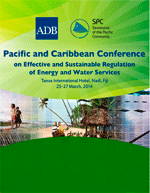 Pacific and Caribbean Conference on Effective and Sustainable Regulation of Energy and Water Services. Conference materials
Pacific and Caribbean Conference on Effective and Sustainable Regulation of Energy and Water Services. Conference materials
Asian Development Bank (ADB). March 2014
This report includes the concept paper and presentations given during the Pacific and Caribbean Conference on Effective and Sustainable Regulation of Power and Water Services in Nadi, Fiji, on 25-27 March 2014. The conference promoted South-South cooperation on effective and sustainable regulation of electricity and water utility services in small island countries in the Caribbean and the Pacific. The concept paper looks at how Pacific islanders need access to adequate, safe water for domestic and commercial uses, such as drinking, sanitation, commercial development or industrial processes but continue to experience limited and unsatisfactory access to power and water services. A selection of PowerPoint presentations from the discussion are included, that intend to provide solutions to some of these problems.
Sources:
- From Rio to Rio: A 20-year Journey to Green the World’s Economies (Chapter 5; Pg 43): Energy Efficiency, Renewable Energy, and Climate Change. Global Environment Facility. 2012
- Gender, water and sanitation. Policy brief. Interagency Task Force on Gender and Water, 2006
- Green Growth, Resources and Resilience: Environmental Sustainability in Asia and the Pacific.
Asian Development Bank (ADB), United Nations Economic and Social Commission for Asia and the Pacific (UNESCAP), United Nations Environment Programme (UNEP). 2012 - Resource guide: Mainstreaming gender in water management.
 United Nations Development Programme (UNDP). 2006
United Nations Development Programme (UNDP). 2006 - Status Report on the application of integrated approaches to water resources management. UN-Water. 2012
- Strengthening Cooperation for Rational and Efficient Use of Water and Energy Resources in Central Asia.
 United Nations Economic Commission for Europe (UNECE), United Nations Economic and Social Commission for Asia and the Pacific (UNESCAP). 2004
United Nations Economic Commission for Europe (UNECE), United Nations Economic and Social Commission for Asia and the Pacific (UNESCAP). 2004 - The Status of the Water-Food-Energy Nexus in Asia and the Pacific.
 United Nations, Economic and Social Commission for the Asia and the Pacific (UNESCAP). 2013
United Nations, Economic and Social Commission for the Asia and the Pacific (UNESCAP). 2013 - Thirsty Energy. World Bank Water and Sanitation Program (WSP). 2013
- Towards a Green Economy: Pathways to Sustainable Development and Poverty Eradication. United Nations Environment Programme (UNEP). 2011
- United Nations World Water Development Report 4. Volume 1: Managing Water under Uncertainty and Risk. United Nations Educational, Scientific and Cultural Organization (UNESCO), United Nations World Water Assessment Programme (WWAP), UN-Water. 2012
- Water Governance for Poverty Reduction.
 United Nations Development Programme (UNDP). 2004
United Nations Development Programme (UNDP). 2004 - Water Security & the Global Water Agenda: A UN-Water Analytical Brief.
 UN-Water, United Nations University (UNU), United Nations Economic and Social Commission for Asia and the Pacific (UNESCAP). 2013
UN-Water, United Nations University (UNU), United Nations Economic and Social Commission for Asia and the Pacific (UNESCAP). 2013
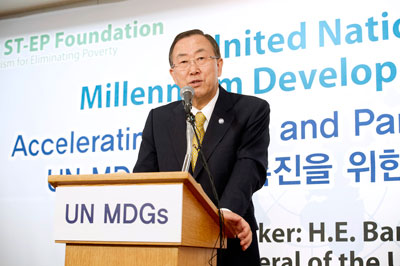
"As the world charts a more sustainable future, the crucial interplay among water, food and energy is one of the most formidable challenges we face. Without water there is no dignity and no escape from poverty,"
UN Secretary-General Ban Ki-moon on his message for World Water Day 2011
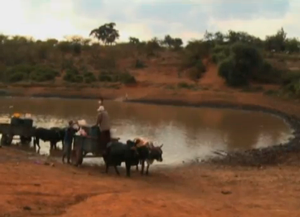
>> Water Scarcity
UNTV 21st Century, November 2011
Place: Kenya
Duration: 3mins49sec
In Kenya, the International Atomic Energy Agency is helping farmers make the most of limited water resources. Innovative irrigation and nuclear techniques enable communities to grow stronger crops while protecting the environment.
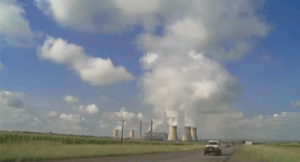
>> Coal's Lethal Legacy
UNTV 21st Century, May 2012
Place: South Africa
Duration: 11mins14sec
The world is becoming desperately short of freshwater, threatening our very survival. In South Africa, the country's water supply is at risk as the nation's energy needs grow. Can this be turned around before it's too late? This video highlights energy and water imbalance linking security of energy and water towards a sustainable future.
>> Why Does the Energy Sector Need Water?
World Bank's Infographics from Thirsty Energy Initiative
>> Thirsty Energy: Energy and Water's Interdependence
World Bank's Infographics from Thirsty Energy Initiative.
>> Infographic on Water and Energy for a sustainable future
Based on contents extracted from UN World Water Development Report 5, this infographic presents the challenges of meeting the water and energy needs for people and societies in the context of sustainable development.
>> Information brief on water and energy
>> Information brief on water and energy efficiency
>> Information brief on securing access to water and energy
>> Information brief on water and energy sustainability
>> Facts and figures on Water and Energy
This web section offers a selection of facts and figures extracted from World Water Development Report 3 (WWDR3), Water in a Changing World, 2009. The section provides various facts on water and energy interdependencies.
>> Facts and figures on Water and Industry
This web section offers a selection of facts and figures extracted from WWDR3. In this section you will find about industry’s water and energy demand and how it varies across countries; it also addresses global water pollution issues.
Copyright | Terms of use | Privacy notice | Site Index | Fraud alert | Help




